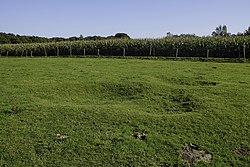Large stone graves near Glimmen
| Large stone graves near Glimmen Hunebed G2, Hunebed G3 Glimmen-Noord, Glimmen-Zuid |
||
|---|---|---|
|
Location of the giant stone grave G3 near Glimmen |
||
|
|
||
| Coordinates | Glimmer G2 , Glimmer G3 | |
| place | Groningen , OT Glimmen , Groningen , Netherlands | |
| Emergence | 3470 to 2760 BC Chr. | |
| van Giffen no. | G2, G3 | |
The megalithic graves near Glimmen (also called megalithic graves near Glimmer Es ) were two megalithic graves of the Neolithic western group of the funnel beaker culture near Glimmen , a district of Groningen in the Dutch province of Groningen . They were largely destroyed at an unknown point in time. Their remains were discovered in 1966 and archaeologically examined between 1969 and 1971 . The graves bear the Van Giffen numbers G2 and G3.
location
The two graves were located southeast of Glimmen in a field on both sides of the Oude Schoolweg. Grave G3 is about 100 m west-southwest of G2. There are several other large stone graves in the immediate vicinity: 2 km north was the destroyed large stone grave Onnen (G4), 2.3 km southeast is the preserved large stone grave Noordlaren (G1) and 3.5 km southeast the two large stone graves at Midlaren (D3 and D4).
Research history
It is unclear exactly when the two graves were destroyed. There are no records mentioning them before the mid-20th century. Ceramic finds suggest destruction as early as the Middle Ages . Maybe their stones were used to build the Sint-Walburgkerk in Groningen. The remains of the two plants were only 1,966 of January Evert Musch discovered that at a field inspection on two conspicuous concentrations of granite - Grus met. Jan N. Lanting then carried out archaeological excavations, first in autumn 1969 and spring 1970 at grave G2 and in 1971 at grave G3. The processing of the finds was carried out by Anna Brindley .
description
Grave G2
The complex was an east-north-east-west-south-west oriented passage grave . The burial chamber had a length of about 11.5 m and a width of about 2 m. It had seven pairs of wall stones on the long sides and one end stone each on the narrow sides. Lanting was also able to make out traces of a corridor and a stone enclosure.
Grave G3
G3 was a south-east-north-west oriented passage grave. The burial chamber was about 3.2 m long. It had two pairs of wall stones on the long sides and one end stone each on the narrow sides. The position of the entrance could no longer be determined. The location of the grave is still indicated by a few shallow pits.
Finds
Both graves contained numerous finds. A large number of ceramic shards originate from G2 and have been reconstructed into 360 vessels of the funnel beaker culture. Furthermore, 50 Bernstein - beads , three flint - hatchets , about 100 cross-edged arrowheads , two blades and other flint artifacts found. Further finds show that the grave was subsequently used in the late Neolithic . These include shards of a large amphora of the individual grave culture as well as shards of three bell beakers and flint tools from the bell beaker culture .
The shards of 33 vessels from the funnel beaker culture , including a dolmen bottle, come from grave G3 . In addition, fragments of a medieval ball pot were found, which suggests that the facility was destroyed as early as the 10th or 11th century.
The funnel beaker ceramics dates from levels 2–5 and 7 of the typological system of the funnel beaker western group established by Anna Brindley . This corresponds to the period 3470–3075 and 2860–2760 BC. Chr.
literature
- Jan Albert Bakker : A list of the extant and formerly present hunebedden in the Netherlands. In: Palaeohistoria. Volume 30, 1988, pp. 63-72 ( online ).
- Jan Albert Bakker: The Dutch Hunebedden. Megalithic Tombs of the Funnel Beaker Culture. International Monographs in Prehistory, Ann Arbor 1992, ISBN 1-87962-102-9 .
- Jan Albert Bakker: Megalithic Research in the Netherlands, 1547-1911. From 'Giant's Beds' and 'Pillars of Hercules' to accurate investigations. Sidestone Press, Leiden 2010, ISBN 9789088900341 , pp. 203-204 ( online version ).
- Anna L. Brindley : The Finds from Hunebed G3 on the Glimmer Es, mun. of Haren, province of Groningen, The Netherlands. In: Helinium. Volume 23, 1983, pp. 209-216 ( online ).
- Anna L. Brindley: Hunebed G2: excavation and finds. In: Palaeohistoria. Volume 28, 1986, pp. 27-92 ( online ).
- Albert Egges van Giffen : De Hunebedden in Nederland , 3 volumes. Oosthoek, Utrecht 1925.
- Evert van Ginkel , Sake Jager, Wijnand van der Sanden: Hunebedden. Monuments van een steentijdcultuur. Uniepers, Abcoude 1999, ISBN 978-9068252026 , p. 193.
- Jan N. Lanting : De NO-Nederlandse / NW-Duitse Klokbekergroep: culturele achtergrond, typologie van het aardewerk, datering, verspreiding en grafritueel. In: Palaeohistoria. Volume 49/50, 2007/2008 (2008), pp. 258-259 ( online ).
- Nynke de Vries: Excavating the Elite? Social stratification based on cremated remains in the Dutch hunebedden. Master thesis, Groningen 2015 ( online ).
Web links
- The Megalithic Portal: G2 Glimmer Es , G3 Glimmer Es
- hunebeddeninfo.nl: G2 / Glimmen (Glimmeres), gemeente Haren , G3 / Glimmen (Glimmeres), gemeente Haren
Individual evidence
- ↑ Esther Scheele: De zoektocht naar G4 / The search for G4. 2012, p. [2] ( online ).
- ^ Anna L. Brindley: The typochronology of TRB West Group pottery. In: Palaeohistoria. Volume 28, 1986, pp. 93-132 ( online ).
- ^ Annual figures corrected according to Moritz Mennenga : Between Elbe and Ems. The settlements of the funnel beaker culture in northwest Germany (= early monumentality and social differentiation. Volume 13). Habelt, Bonn 2017, ISBN 978-3-7749-4118-2 , p. 93 ( online ).

